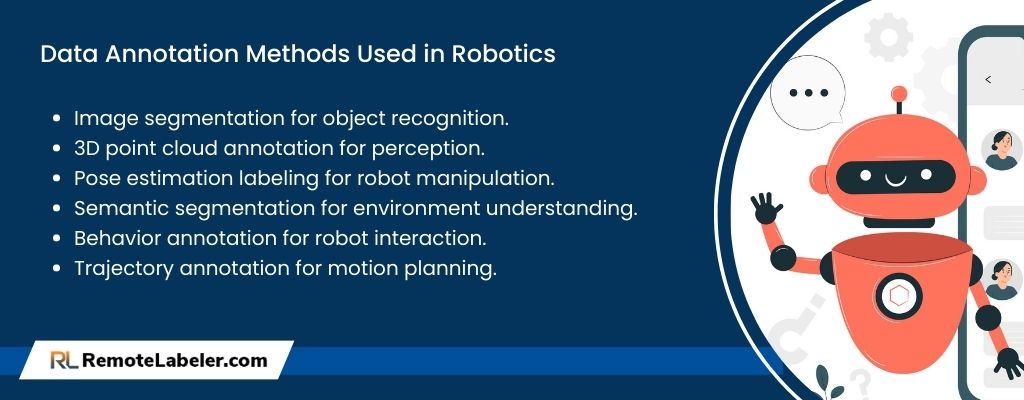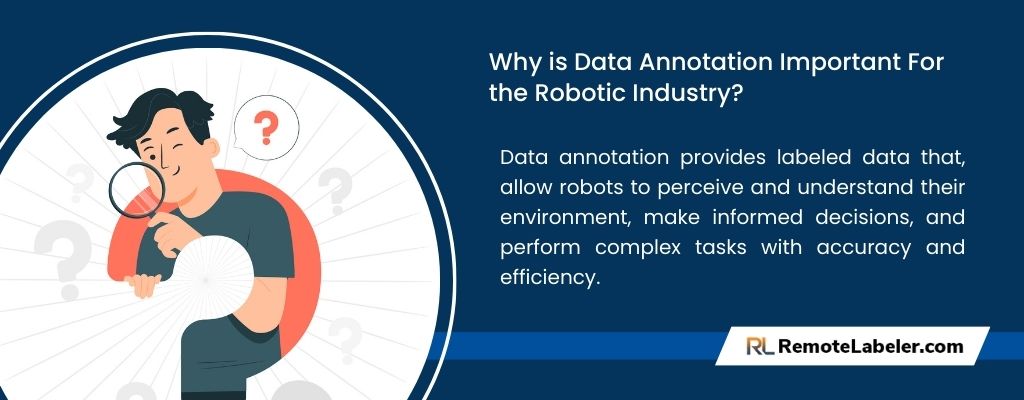With the advancement of technology, robotics has been a game-changer in various industries. However, for these robots to function effectively, they require accurate and high-quality data. This is where data annotation, a crucial step in machine learning, comes in. In this article, we will discuss the best practices for robotics data annotation to enhance machine learning models and how Remote Labeler can help you with your data annotation needs, specifically in robotics and machine learning.
Different Types of Data Annotation Methods Used in Robotics
Robotics data annotation involves the process of labeling data to create machine learning models for robotics applications, such as deep learning in robotics and artificial intelligence in robots. These applications require accurate and reliable data to improve their functionality, safety, and efficiency. The process of data annotation in robotics, including robotics data labeling, can be challenging and time-consuming due to the complexity of the data.

Thus, in robotics, data annotation is a critical process for building effective machine learning models. There are several different types of data annotation methods that are commonly used in robotics. Here are some of the most common types of data annotation methods:
- Image annotation:
Image labeling is a popular method used for object detection in robotics. It involves labeling specific objects or features in an image using bounding boxes, polygons, or points. This method is commonly used in robotics for tasks such as object recognition, navigation, and tracking.
- Semantic segmentation:
Semantic segmentation is a more advanced image annotation method that involves labeling every pixel in an image with a specific class label. This method is used to create detailed maps of environments or objects, which can be useful for robot navigation and obstacle avoidance.
- 3D annotation:
3D annotation involves labeling objects in a 3D space, such as identifying objects in a point cloud. This method is commonly used in robotics for tasks such as robotic manipulation and grasping.
- Sensor data annotation:
Sensor data annotation is the process of labeling sensor data with different events or activities. This method is used in robotics for activity recognition and behavior analysis. Sensor data annotation can be done using timestamps or labeling sensor data with different categories.
- Speech annotation:
Speech annotation involves transcribing audio data into text. This method is used to train speech recognition models for robots that can communicate with humans through voice commands.
- Natural language processing (NLP) annotation:
NLP annotation involves labeling text data with specific categories, such as sentiment or intent. This method is used to train NLP models for robots that can interpret and respond to human language.
Each of these data annotation methods has its own specific use cases and benefits, and it’s important to choose the right method for the task at hand. At Remote Labeler, we have experience with all of these annotation methods and can provide high-quality annotation services to help enhance your robotics machine learning models.
Best Practices for Robotics Data Annotation
Accurate and consistent data annotation is an essential aspect of machine learning in robotics applications. Without properly annotated data, machine learning robots models will not be able to learn and make accurate predictions. The process of robotics data annotation involves labeling the data with relevant information, such as object names, locations, and attributes, which is then used to train machine learning models.

To achieve accurate and consistent data annotation in robotics, it’s important to follow best practices. These practices not only help to ensure the quality of the annotation but also make the process more efficient and manageable. In this section, we’ll discuss some of the key best practices for robotics data annotation.
Following these practices will help to ensure that the data is correctly annotated, that the annotation process is efficient and manageable, and that the machine learning models built from the annotated data are accurate and effective.
Clear and concise guidelines:
Providing clear and concise annotation guidelines is essential for ensuring consistent and accurate annotation across different annotators. Guidelines should include details on what needs to be annotated, how it should be annotated, and any specific requirements for the annotation tool being used.
Managing complex and large datasets:
Managing complex and large datasets can be a challenge when it comes to data annotation. It is important to have a system in place for organizing the data and ensuring that all data is properly annotated. This may involve breaking down the data into smaller, more manageable sets, or using specialized tools for managing large datasets.
Quality control and verification processes:
Quality control and verification processes are essential for ensuring accuracy and consistency in data annotation. This may involve having multiple annotators review the same data to ensure that annotations are consistent, or using automated tools for verifying annotations.
Continuous improvement and feedback loops:
Data annotation is an ongoing process, and it is important to continuously review and improve the annotation process to ensure the highest quality results. This may involve collecting feedback from annotators and making changes to the annotation guidelines or processes based on that feedback, or using machine learning to automatically improve the quality of annotations over time.
Enhancing Machine Learning Models with Quality Data Annotation
High-quality data annotation has a significant impact on the performance and accuracy of machine learning models. Quality data annotation ensures that the machine learning for robotic models are well-trained, which, in turn, improves their functionality, safety, and efficiency. Remote Labeler’s expertise in providing high-quality data labeling and annotation services ensures that the machine learning models are well-trained and achieve optimal performance.
There are numerous examples of successful robotics applications that have been enhanced by quality data annotation, particularly in the fields of deep learning robotics and machine learning for robotics. For instance, autonomous vehicles rely heavily on data annotation to ensure safety and efficient operation. Similarly, robots used in manufacturing require accurate and reliable data to improve their performance and efficiency.
Continuous improvement and feedback loops are essential in the data annotation process to further enhance machine learning models in robotics. The process of data annotation should be iterative, with frequent feedback provided to the data annotators to ensure that they understand the expectations and standards required for successful implementation of deep learning and machine learning models in robotics.

Conclusion
Data annotation is a critical process in robotics that requires specialized expertise to ensure accuracy and reliability. The best practices for robotics data annotation discussed in this article include clear and concise annotation guidelines, managing complex and large datasets, and quality control and verification processes. High-quality outsource data labeling has a significant impact on the performance and accuracy of machine learning models. Remote Labeler’s expertise in providing high-quality data annotation services ensures that your machine learning models achieve optimal performance. Reach out to Remote Labeler for your data annotation needs.
- Emerging Trends and Future Outlook: The Data Labeling Industry in 2024-2030 - December 8, 2023
- Landmark Annotation: Key Points - November 6, 2023
- All You Should Know About Bounding Box Annotation - November 5, 2023